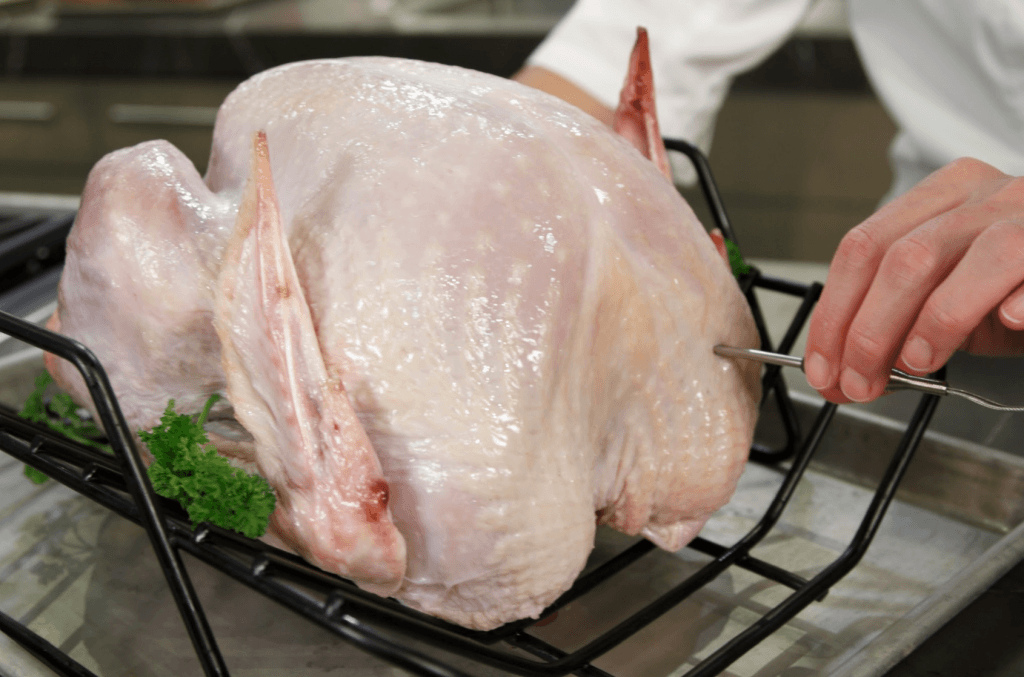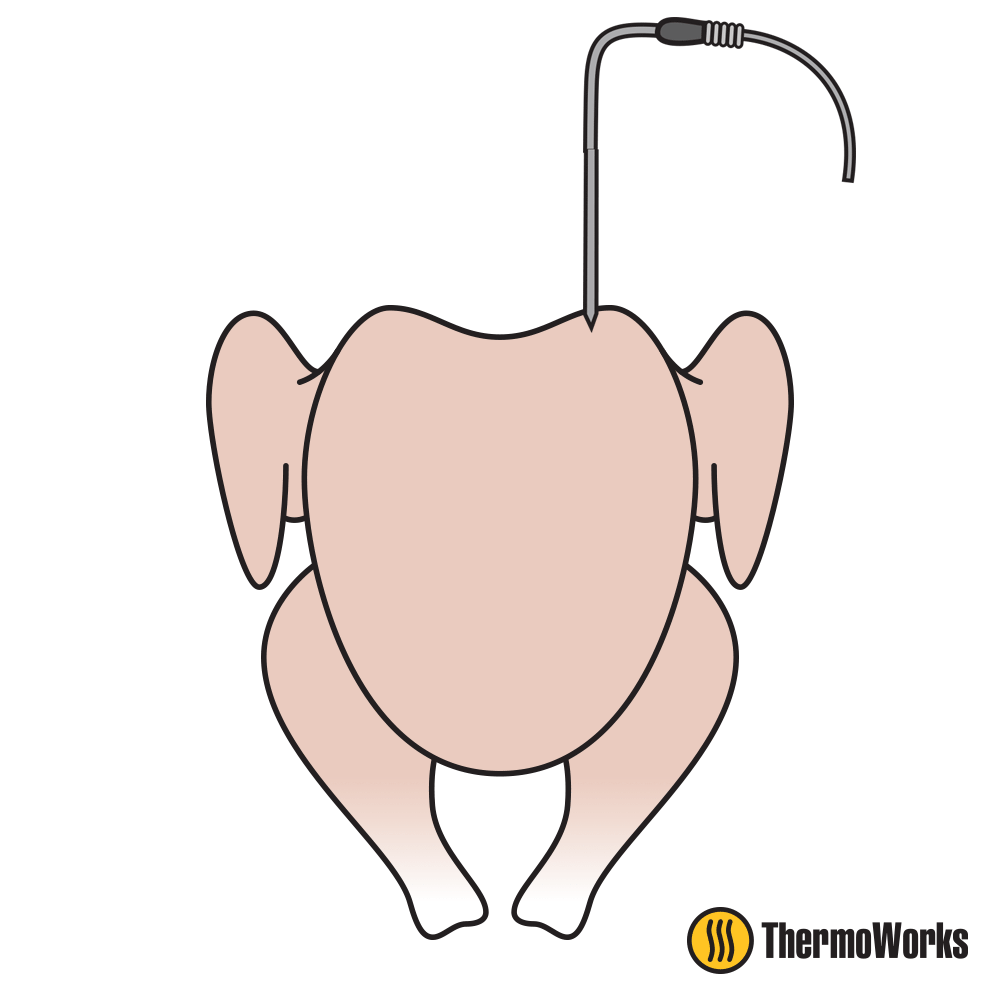Thanksgiving is one of the most food-centered days of the year, and just about the only time for a Turkey to shine. In this post, we’ll help you with one of the key principles of turkey cooking that you need to get a perfect bird this year!
While you can find any number of turkey recipes with varying methods and flavors they all have one thing in common: making sure your turkey is properly cooked. And the thermal principles that we talk about here for cooking your turkey are applicable to any recipe.
Cooking the perfect turkey can feel like an intimidating task. With only one shot on Turkey Day you want to make sure you nail it. Monitoring the temperature with a high-quality leave-in thermometer is key to serving up juicy flavorful meat. But simply having a thermometer isn’t enough – you also need to know exactly where to place the probe in the turkey. Proper placement ensures an accurate reading so you know precisely when your bird is done.
Why Temperature Probing is Essential
A leave-in thermometer with an oven-safe probe allows you to track the turkey’s temperature in real time without repeatedly opening the oven door. Opening the door frequently causes drastic temperature drops that can negatively affect cooking.
Cooking times provided on turkey packaging are simply estimates Every oven cooks differently and the size, shape and density of each bird varies. The only way to know exactly when your specific turkey is perfectly cooked is to use a thermometer
Relying on the pop-up indicator on a turkey or checking color to gauge doneness leads to overcooking. Once the breast meat dries out, you can’t reverse it. But an accurate probe will alert you when the turkey reaches the ideal finish temperature so you can pull it from the oven at the exact right moment for tender, juicy meat.
Choosing the Right Thermometer
The best probes for turkey have these features:
- Oven-safe cable and probe handle
- Fast and accurate temperature response
- Small probe tip to easily insert into meat
- Programmable alarm when preset temperature is reached
- Wireless remote receiver with temperature display
Examples of high-quality leave-in thermometers are the ChefAlarm and DOT
Instant-read thermometers like the Thermapen One are ideal for quick temp checks. Verify temperature in multiple areas once the turkey is done cooking.
Proper Probe Placement
Choosing where to insert the probe is one of the most critical steps in perfectly cooking your turkey. Follow these guidelines:
Insert Horizontally into Thickest Part of Breast
The probe tip should rest in the very center of the thickest portion of breast meat, deep enough to measure the internal temp without hitting bone.
Aim to have the probe tip located about 1-1 1/2 inches from the cavity opening. Angling it horizontally from near the neck opening often allows the best access.
Avoid Bone
Be very careful to place the probe in an area of solid meat, avoiding any bones. Bone conducts heat differently than meat and will not provide an accurate reading of the meat temperature.
Consider Proper Minimum Immersion Depth
The probe tip only needs to be inserted 1/4 to 1/2 inch into the meat in order to get an accurate temp reading. This minimal depth enables precise temperature measurement in the very center of the breast tissue.
Allow Space Above and Below Probe
You want the probe running through the true thermal center of the breast. Try to position it with roughly equal amounts of meat above and below the probe tip so it is fully surrounded by turkey meat.
Repeat on Other Areas
Once the turkey comes out of the oven, verify the temp by probing the thickest section of thigh and wing using an instant-read thermometer. Check multiple areas to confirm the turkey is fully cooked.
Watch for Carryover Cooking
As the cooked turkey rests, the internal temperature will continue rising 5-10°F from carryover cooking. Pull the turkey once the lowest probe temp reaches 5-10°F below your target finished temperature.
Common Probe Placement Mistakes
It’s easy to accidentally misplace your probe. Avoid these common errors:
-
Placing the probe right against bones
-
Not inserting deep enough into the breast center
-
Allowing the probe to touch the roasting pan
-
Positioning too close to the cavity opening
-
Angling down through the neck cavity rather than horizontally
Any of these mistakes will lead to incorrect temperature readings.
Handling Raw Turkey Safely
When inserting your probe and handling raw poultry:
-
Wash hands thoroughly before and after
-
Use a clean probe each time – do not reuse without washing
-
Sanitize any surfaces the raw turkey contacts
-
Never place cooked foods back on surfaces/platters that held raw turkey
Take the Guesswork Out of Roasting
Don’t let fears of undercooked or dried-out turkey ruin your holiday meal. With some thermometer know-how, you can roast the perfect bird every time. Inserting the probe properly delivers accurate temps so you know exactly when your turkey is cooked to juicy, flavorful perfection. Rely on your thermometer, not the clock, to signal turkey time!

How to Place the Probe
 Insert the probe horizontally, from near the neck cavity.
Insert the probe horizontally, from near the neck cavity.- The probe’s tip should be about 1/2 to 1 inch (1.3 to 2.5 cm) from the internal cavity of the bird to avoid touching the bone.
With the probe in place, you’re ready to track the breast’s internal temperature during the cook. Remember that breast and leg meat should cook to different temperatures, but breast is the one that will dry out if overcooked. So make sure you temp that breast! If you want to learn more about how white and dark meat differ, read about it in our comprehensive turkey post.
Understand Your Thermometer’s Probe
For the most accurate probe placement, you need to understand your leave-in thermometer’s probe.
- In the DOT’s probe (or any other Pro-Series probe), the sensor occupies only the very tip (within 1/8 of an inch [.3 cm]) of the end of the probe. A small sensor like that allows you to pinpoint your temperature taking.
How to Insert a Meat Thermometer into Turkey
FAQ
Is turkey done at 165 or 180?
What temperature should a probe be for turkey?
How do you put a thermometer in a turkey breast?
Place the probe of your leave-in thermometer into the deepest part of the turkey breast. According to ThermoWorks, it’s best to enter the turkey horizontally, starting near the neck cavity. The tip should be about 1/2 to 1 inch from the internal cavity.
Where do you put the thermometer in a Turkey?
Place chopped onions, celery, and carrots in the bottom of the roasting pan. Pick a few herbs off the stalks and add to the vegetables. Set aside. Pat dry the turkey with paper towels. Where do I put the thermometer in the turkey? The tip of the thermometer should be placed into the thick part of thigh without touching the bone.
Do you need a thermometer to cook a Turkey?
When cooking a turkey, you need two thermometers, not just one. An oven-safe leave-in probe thermometer to track the cook and an instant-read thermometer to verify its doneness. And the first thing you need to do to ensure perfect turkey doneness at the end of your cook is to pr When cooking a turkey, you need two thermometers, not just one.
How do I Check my Turkey’s temp?
Here’s how to check your turkey’s temp the right way this holiday. An instant-read thermometer is exactly what it sounds like: A thermometer that reads temperatures instantly. Most instant-read thermometers have a handle that displays the temperature and a stainless steel probe that is inserted into food.
